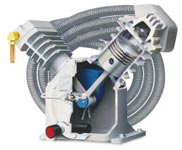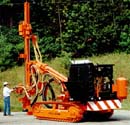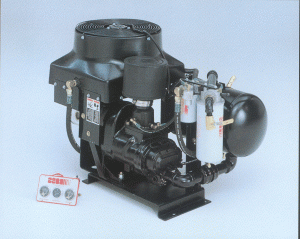Air compressors come in two basic configurations; positive displacement (reciprocating or rotary screw), and dynamic (centrifugals or regenerative). Of these two basic configurations, there exists many variations in their design, and each design will have it’s own advantages and disadvantages when considered in a particular application.
Rotary Screw Compressors
 Rotary screw air compressors are the more common compressor used in industries today. Inherently by design they are approximately 25% more efficient than a reciprocating “piston” type of air compressor. Sizes of the rotary screw now very from five horse to several hundred. Discharge pressures can now range upwards of 350 PSIG. At approximately 10 horsepower, a rotary screw type of air compressor will cost about the same as a good quality reciprocating unit.
Rotary screw air compressors are the more common compressor used in industries today. Inherently by design they are approximately 25% more efficient than a reciprocating “piston” type of air compressor. Sizes of the rotary screw now very from five horse to several hundred. Discharge pressures can now range upwards of 350 PSIG. At approximately 10 horsepower, a rotary screw type of air compressor will cost about the same as a good quality reciprocating unit.
Reciprocating Compressors
 Reciprocating or piston type of air compressors, although less efficient than a rotary screw most assuredly still have a position in the marketplace. The most common use today is small applications, as well as low flow and high-pressure applications. Due to the ease of multiple staging of the reciprocating air compressor, these units can easily be designed to drive compressed air discharge pressures to as high as 9000 PSIG. Pressure lube and the standard splash lube are both available.
Reciprocating or piston type of air compressors, although less efficient than a rotary screw most assuredly still have a position in the marketplace. The most common use today is small applications, as well as low flow and high-pressure applications. Due to the ease of multiple staging of the reciprocating air compressor, these units can easily be designed to drive compressed air discharge pressures to as high as 9000 PSIG. Pressure lube and the standard splash lube are both available.
Industrial
Pneumotech Inc. deals essentially in high quality, heavy-duty, long life industrial equipment. We do have and occasionally we do sell, some of the lighter duty equipment. We have proven time and time again throughout the years, that compressed air is essentially another utility, such as the telephone, electricity or natural gas. Like these utilities, personnel tend to find many uses for compressed air once they discover it’s inherent conveniences.
Because many facilities dependant on reliable air would be required to stop operations if they had compressed air problems, air compressors are an essential piece of equipment for continued daily operations. As such, light-duty units with less than an 80% duty cycle do not lend themselves well to these applications.
Portable and PTO

This category includes portable air compressors and track drills that are diesel, gas, natural gas, or hydraulically powered, and in rotary screw, rotary vane or reciprocating styles.

Power take-off or “P.T.O.” packages are available in under deck, above deck, and split shaft configurations.
Portable vacuum pumps and compressed air treatment equipment is also available.
Although still available the portable reciprocating air compressor has pretty much gone the way of the dinosaur and as such almost all of the offerings are rotary screws.
Pneumotech not only services these units but also has the competent technical expertise for installation as well as a knowledgeable sales staff specializing in this type of utility equipment.
Oil Free Air
Oil free compressed air can be achieved in many ways. Although many manufacturers produce oil free compressors both in the reciprocating and rotary screw configuration, as well as centrifugals; you still require proper compressed air treatment prior to using the air for your process. Modern filtration and compressed air purification techniques can clean the air stream to far better quality than one could ever hope to achieve with an oil free air compressor by itself. Although we sell oil free air compressors, we find them to be exorbitantly expensive to maintain and operate, let alone purchase, when compared to the standard oil flooded/lubricated air compressor. Even a water sealed liquid ring compressor is generally a far superior choice, if you are instant on an oil free unit.

Breathing Air
Compressed air used for human respiration must meet or exceed quality verification level “D” per ANSI/CGA G-7.1-1989, more commonly referred to as grade “D” breathing air. Over the years, Pneumotech has specified, installed and maintained many of these specialty or individualized units. They are available both in high-pressure versions for filling tanks and low-pressure versions for on-site respiration.

In the case of low-pressure versions, it is quite often not too difficult to take a pre-designed package such as one of our instrument air systems, make some slight modifications, and produce low-pressure Grade “D” breathing air that is both suitable and safe for respiration.
Contact Sales
We would be more than pleased to assist you in determining your needs.
We take the time to determine the most advantageous design for your particular application prior to giving any recommendation, including:
- careful consideration of cost of operation
- overall operational life of the equipment
- CFM of the compressed air required
- the maximum discharge pressure required
- the ability of your facilities maintenance personnel
- available budget.

